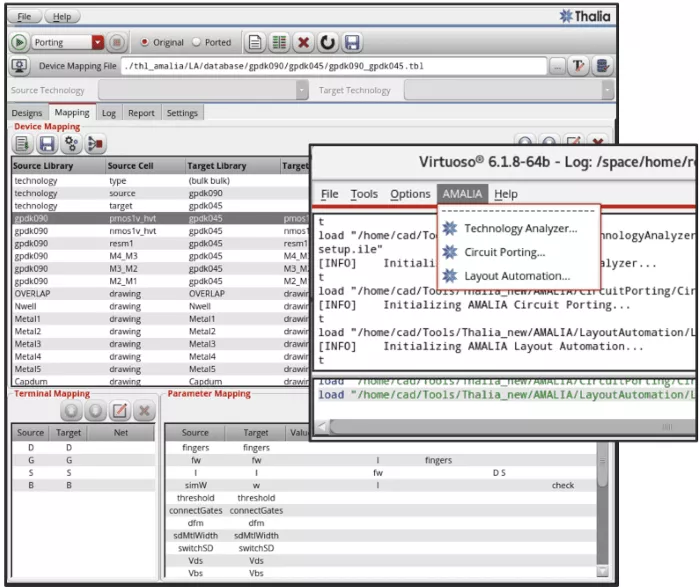Thalia Announces Latest Version of AMALIA with Game-Changing ‘Device-Stretching’ Algorithm and Flip Well Intelligence
Cwmbran, United Kingdom – February 11, 2025 – Thalia Design Automation is thrilled to announce the immediate availability of the latest version of the AMALIA Suite, their AI-powered industry end-to-end IP reuse platform.
This release brings significant enhancements throughout AMALIA, particularly within its Layout Automation Suite. The solution retains the intrinsic value of production silicon, delivering the final step in the design migration flow. It employs a custom AI Design Transformer engine for analog physical implementation, leveraging the source layout and PDK. The migrated layout maintains the existing floorplan, ensuring DRC/LVS integrity. With AMALIA, customers can have a dedicated solution to the challenge of analog and mixed-signal migration and reliably achieve migration design time savings of up to 40%.

“Our mantra is to continually drive down migration design cycle time and we achieve this with dramatic steps at each major release of AMALIA,” said Thalia’s CEO, Sowmyan Rajagopalan. “We’ve introduced a game-changer within the Layout Automation Suite with a new device-stretching algorithm, metal stacking, along with significant functionality enhancements to automate the identification and migration to Flip Well designs for FDSOI.”
IP layout migration from one silicon process to another often encounters challenges due to varying PCell sizes. This results in open and shorts when trying to maintain the floor plan between the source and target technology. Fixing this manually can be a very time consuming. AMALIA’s new ‘device-stretching’ algorithm solves this issue while preserving the floorplan, delivering DRC-clean results, and promising substantial time savings.
For designs migrating to or from FDSOI, new analysis capabilities in AMALIA’s Technology Analyzer solution can identify standard transistor versus Flip Well devices and their unique electrical connection requirements, This knowledge seamlessly carries through to the Circuit Porting phase of migration, where AMALIA efficiently guides the user with their relevant design options.
These new capabilities – the device stretching algorithm, metal stacking and the analysis for Flip Well devices – represent significant advances in AMALIA.Thalia’s customers have experienced design cycle time reductions of up to 40%, thanks to continuous advances in the tool suite. This latest product release reinforces AMALIA’s unique position in analog design and IP migration.
For more information, visit thalia-da.com or contact us here.
Summary of capabilities added to AMALIA products in release 24.4
- Layout Automation Suite
- New device-stretching algorithm
- Smart vias porting to achieve DRC-clean vias
- Improved device mapping generator
- Devices shifting based on layer combination
- Design Enabler
- Enhancements to rapidly identify devices that impact circuit performance
- Circuit Porting Suite
- Flip well identification and related unique connections
- Conditional device mapping and improved generator
- Circuit area calculation
- Technology Analyzer
- Preference driven device mapping
- Flip Well design recognition in FDSOI process technology
- AI device recognition and analysis
- Enhanced waveform interpolation algorithm

Figure 2: Layout Automation Suite GUI and AMALIA integration within Cadence Virtuoso
Related Semiconductor IP
- HBM4 PHY IP
- Ultra-Low-Power LPDDR3/LPDDR2/DDR3L Combo Subsystem
- HBM4 Controller IP
- IPSEC AES-256-GCM (Standalone IPsec)
- Parameterizable compact BCH codec
Related News
- Arasan Announces immediate availability of its Total IP for Embedded USB2 (eUSB2) with Controller and PHY
- Credo Announces Changes to Board, Appointing Brian Kelleher, Former Senior Vice President of Engineering with NVIDIA, to Independent Director Role
- Thalia Design Automation announces AMALIA Platform release 25.3 qualified for advanced process nodes down to 4nm
- Perceptia Announces Availability of Cryogenic 10-bit ADC and DAC IP in GF 22FDX
Latest News
- Cyient Semiconductors Acquires Majority Stake in Kinetic Technologies to Drive Custom Power IC Leadership for Edge AI and High-Performance Compute Markets
- Rivian Unveils Custom Silicon, Next-Gen Autonomy Platform, and Deep AI Integration
- NanoXplore raises €20 million from MBDA and Bpifrance to accelerate its diversification into defense and its growth in support of European strategic sovereignty
- Omni Design Technologies Appoints Hinesh Shah as Vice President of Strategic Sales
- DHRUV64: India’s First 1.0 GHz, 64-bit dual-core Microprocessor